This is going to be a long post written to address anyone who is trying to integrate after market amplifiers and speakers to an OEM HU and has a limited budget. If the "history lesson" does not interest you, drill down to the "
Upgrading your OEM car audio on a budget" title in this post. For the rest, here goes...
Preamble
The center console that once had just one use - that of music playback - now functions as an information center as well. In most cars sold today, this screen not only works as the stereo system but also Satellite navigation, Reversing cameras, Battery condition, Trip analysis, and more.
Some new cars have screens that do the duty that dash board sensors once did and display Engine Condition, Coolant Temperature, Oil Pressure, Tyre Pressure, Headlight and Indicator Lamp warnings, Brake Fluid/Brake Pad Condition/ABS, Traction Control Status/Fault, and a whole host of indicators including some as inane as a sensor telling you if the Petrol Cap has been tightened correctly.
With "INFO-tainment" replacing "Entertainment" car owners are unwilling to remove the central computing unit and it's screen and replace it just for the purpose of better quality sound.
With the exception of a few luxury car models, car audio is often an afterthought and the budget manufacturers allocate to it is dismal. If you removed the speaker from any mid-priced or semi-luxury hatch or sedan (anything between the i10 and the Toyota Camry) today you would be alarmed at the quality of components used.
This compromise is most often in the speakers. To compensate for the limitations of these paltry speakers many OEM HUs are heavily equalized especially at the frequency extremes (bass and treble). As a system the combination of the heavily equalized HU and sub-standard speakers is just about tolerable however the sound is often compressed in dynamic range and lifeless.
The case for after market Digital Signal Processing (DSP)
Members looking to replace the OEM speakers with an amplifier and speakers and retain the OEM HU are on the other hand disappointed as the heavy EQ of the OEM HU now affects the sound of the new speakers which do NOT need this EQ and hence the system sounds boomy or tizzy or both. This is leading to several members being disappointed with the sound despite spending 50-60-70k on their upgrades. In some cases the "upgraded" sound system may sound worse than the OEM speakers.
The solution to this is the use of a DSP. Now using DSPs for car audio is not really new. On November 14,
1982, New York Times Audio Editor, Hans Fantel wrote about the new Cadillac Seville with a revolutionary (for it's era) sound system that was developed jointly by GM, Delco and Bose. Dr. Amar Bose's company first sold the idea to GM to let them develop an audio system that used DSP technology to compensate for the limitations of not only the speakers but more so the locations where these speakers would be installed. The test car (and the first car to be sold with this new system) would be the 1983 Cadillac Seville. Don't ask me how I know this, I am old, very, very, old. See picture below (of a 1984 Seville with the GM-Delco-Bose Head Unit):

Source:
http://momentcar.com/image-modelYear...84-12.jpg.html
I found a clearer picture of the Bose system in a 1985 Cadillac Eldorado

Source:
http://www.fleetofcads.com/lwt85com.htm
The audio system was so popular that in a couple of years all the top end models from all GM marques (Cadillac, Buick, Oldsmobile, Chevrolet, Pontiac) had GM-Delco-Bose systems. Not to be outdone by 1985-87, Toyota teamed up with Fujitsu-Ten (for their Crown), Ford teamed up with JBL (for their Lincoln Town Car) and Chrysler teamed up with Infinity for their Le Baron and Dodge Lancer (Infinity and JBL were both divisions of Harman Industries by this time). Anyway the point is that the use of DSPs in car audio is more than
3 decades old. Those interested can read the links below (detailing the work done for Fujitsu-Ten for the Toyota Crown and Sera). You will notice that both systems were quite sophisticated for their time.
https://www.denso-ten.com/business/t...l/pdf/6-2E.pdf https://www.denso-ten.com/business/t...l/pdf/4-1E.pdf DSP and OEM HU integration today
The aftermarket DSP market started heating up in the early 2000s. By 2005 DSPs from Alpine, Rockford Fosgate, Audison, etc were all vying for the OEM HU market. Each had it's own strengths and combination of features:
DSP features list:- Auto EQ - De-equalize the OEM HU's internal equalization and Re-equalize to after market speakers.
- Selectable input sources
- Process one pair of inputs and produce as many as 12 outputs for front, rear and subwoofer channels.
- Multi-band equalizer (as many as 250 bands) for each channel
- Time delay (Alignment) compensation for each channel
- Bass Expansion (dynamic range expander for sub 200Hz) for the subwoofer channel
- Amplification of the Time and Frequency corrected signal (sometimes a small 20-40W class D amp is included).
For example the Alpine H650 pictured below these DSPs had as many as 250 bands of Equalization per channel and a microphone to be used to auto-equalize and time align the speakers and subwoofer.
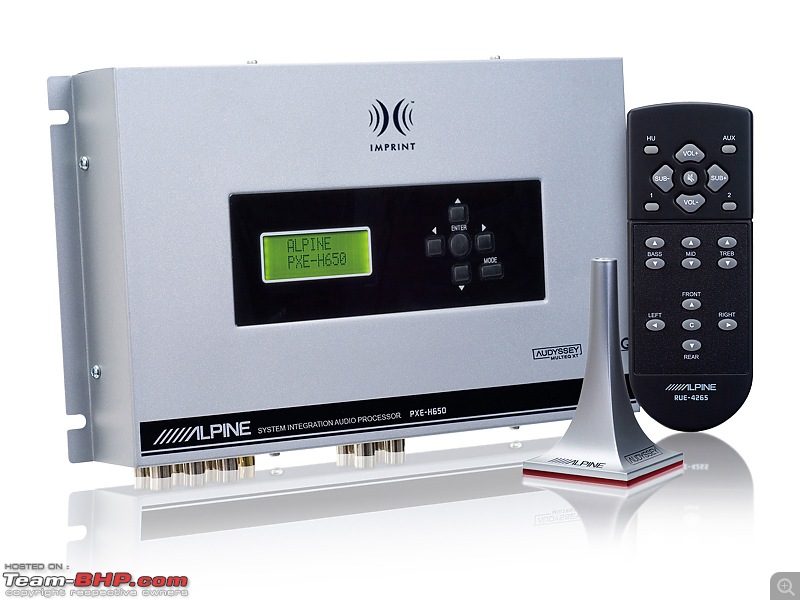
Source:
https://www.alpine-europe.com/p/Prod...ors14/pxe-h650
Not to be left behind by 2008 several TBHPians were using these DSPs in their cars. (see thread below).
https://www.team-bhp.com/forum/car-e...pine-h650.html (RF 3Sixty.2 vs Alpine H650) The Advent of Aftermarket HUs with DSP
Soon after these DSPs were released, car audio manufacturers started introducing DSP functionality in their better models. Models like Alpine 9887 (2008) and Pioneer 80PRS (2012) were among the best and are still respected for the quality of audio they provided. As technology trickled down the lower models also included these same features. Around the same time there was a push away from 1 DIN HUs (7" x 2") to 2 DIN (7" x 4") HUs to accommodate a larger screen and provide even more functionality. Today, most after market HUs have DSPs in them and they cost less than an after market DSP from the likes of Audison, JL Audio, AudioControl, Alpine or Rockford Fosgate.
If your car uses the OEM center console (HU) purely for entertainment and/or if it's functions can be duplicated by an after market HU it is advisable to get a after market HU instead of a DSP (Info-tainment). Today many HUs can not only serve to entertain but also can be used for Reversing Cameras. Satellite Navigation, and Phone Integration so if your OEM console (HU) does not do anything other than this then it makes a lot of sense to get an after market HU from Pioneer, Kenwood, Alpine, etc.. Head Units like the Alpine INE-W960E, Kenwood DNX4150BT, or Pioneer AVH-X399BT all have integrated audio-DSPs as well. The Kenwood HU pictured below is an example - from the screen shot alone you can tell all the features it comes with.
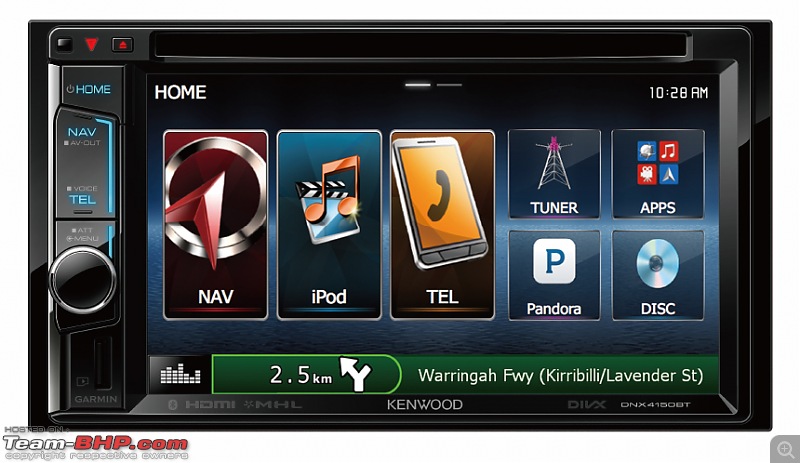
Source:
http://www.kenwood.com/india/car/vis...ion/dnx4150bt/
Compare the Kenwood above to what your father or grandfather had in his car
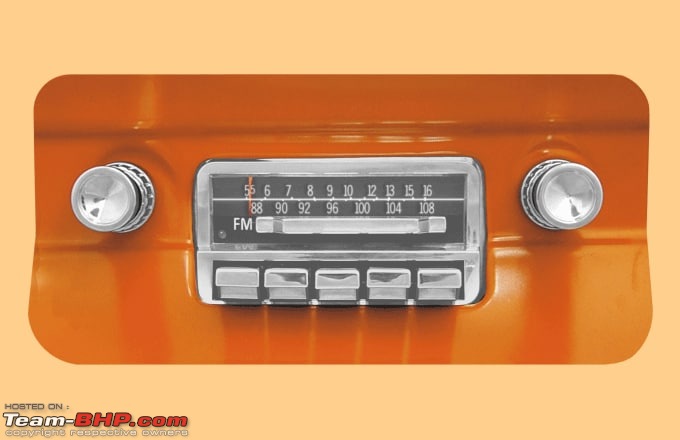
Source:
https://www.complex.com/music/2015/0...c-in-your-car/ The Rock, the Hard Place, and the "Pioneer"
But you have one of the new cars with those fancy INFO-tainment consoles! In most cases these OEM consoles also have extensive equalization for the speakers (as explained earlier) and now you are truly stuck between a rock an a hard place.
The Rock: Leave the OEM system alone and tolerate the limitations of the existing car stereo. So what if the vocals are muffled and unintelligible or the dynamic range compressed so that the musicians sound like the are playing from the bottom of a well.
The Hard Place: Upgrade. But if you were to buy an amplifier, subwoofer and speakers you may now have music that while not compressed or unintelligible can sound boomy and/or tizzy or both.
This is really a tough choice. Seems like car manufacturers have conspired to ensure that good audio will only come if you sacrifice your TPMS, ESP, ABS, Trip and FE display, and all the other functionality that your center console offers. 6-8 channel DSPs from Alpine, Audison, Mosconi, Rockford Fosgate, Audio Control cost between Rs. 50,000 to 80,000 and few cost even more. This means that for the majority of us, we would have to double our car audio budgets just to ensure that the after market amplifiers and speakers we have installed (or want to install) sound musical.
In 2010 JBL introduced the MS8 (a product whose launch was so delayed that most people called it the MS-late). The MS8 incorporated not only a sophisticated DSP but also 8 channels of amplification and Logic 7 all in one box. All the press and attention the MS8 garnered forced JL Audio to develop the Vxi series, Audison introduced the Prima series, and Helix and Mosconi their DSP series range of amplifiers. These will be discussed later (see below).
Upgrading your OEM car audio on a budget
A couple of days ago fellow TBHPian
shreyak_ss sent me a link for the Pioneer DEQ S1000a. This device offers 6 channels of DSP and 4 x 22W channels amplification but permits the addition of external amplifiers so one can add an external 4 channel amp (for the front and rear speakers) or a monoblock (for the subwoofer) or both and use the S1000a as a DSP.
To the best of my knowledge this is the
cheapest DSP that offers
Auto EQ (De-equalize the OEM HU and Re-equalize to new speakers and ampligiers). It comes at
20% of the cost of similar (but better powered and built) devices from companies like JL Audio or Audison.
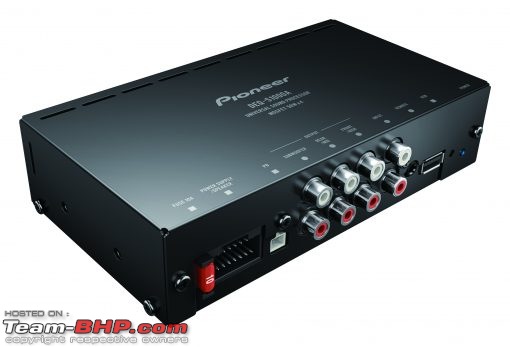
Source:
https://www.pioneer-india.in/buy/car...or/deq-s1000a/
More details in the links below:
https://pioneer-india.in/media/produ...pp_KeDpAwL.pdf https://www.pioneer-car.eu/eur/sites...elease_pee.pdf
At under Rs. 12,000 the Pioneer costs less than half of it's nearest competitor the Sony-GS6DSP (Rs. 26,000). The Sony however offers not only 4.1 channels of DSP but also
45 W x 4 + 300W x 1 channels amplification so is a 'more complete'
"one-box" solution than the Pioneer.
https://www.sony.co.in/electronics/c...iers/xm-gs6dsp
At Rs. 12k and 26k respectively the Sony and Pioneer offer good value compared to the Audison AV 5.1K, JL VX1000/5i, Helix P SIX DSP mk2, Mosconi D2 80.6, which sell for over Rs. 1.3L ($1200-1600) or even the Rs. 90,000 JL VX700/5i. (see picture below).
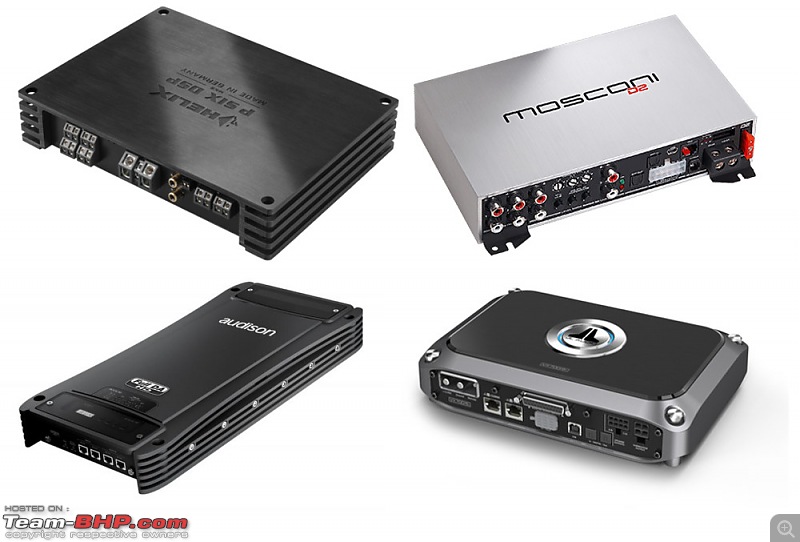
At around 65-75k (depending who imports it) the Kenwood XR600-6DSP is the next cheapest solution to the Sony but required an additional investment of their iDatalink Maestro AR (see video below). The Kenwood however does offer almost twice the power of the Sony (on par with the Audison, JL, Helix, and Mosconi pictured above).
Sure the more expensive DSP-amplifiers have more power and better build and sound quality than the Sony or Pioneer but they are
5 times more expensive. The other alternate of a dedicated 6-8 channel DSP from Alpine, Audison etc. would cost you 50k+ and then you still have to add 5+ channels of amplification.
Why, if you have room for external amplifiers, you can add a 70W 4ch. and a 300W mono-block to the Pioneer for about 30-35k and still have a DSP + amplifier combo that, at 45-50k, costs little more than half the Kenwood XR600-6DSP or the JL VX700/5i.
While they (the Sony or Pioneer) do NOT offer the same power capability, build, or sound quality of the JL, Audison etc. they are great value for money.

 (89)
Thanks
(89)
Thanks

 (1)
Thanks
(1)
Thanks
 (8)
Thanks
(8)
Thanks

 (15)
Thanks
(15)
Thanks
 (12)
Thanks
(12)
Thanks
 (1)
Thanks
(1)
Thanks

 (1)
Thanks
(1)
Thanks












